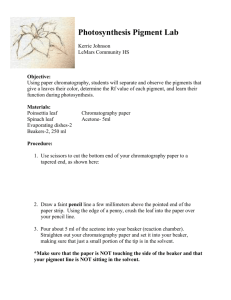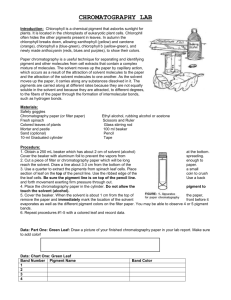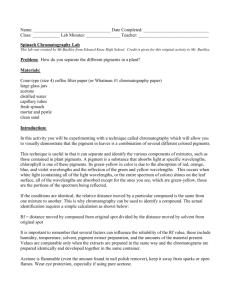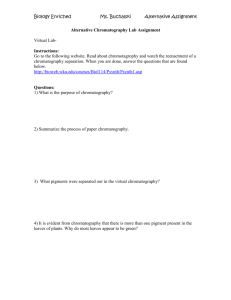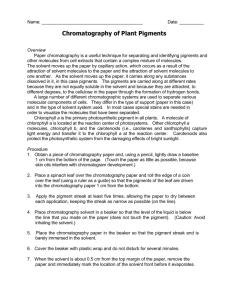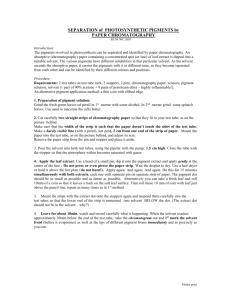Chromatography Lab_revised
advertisement
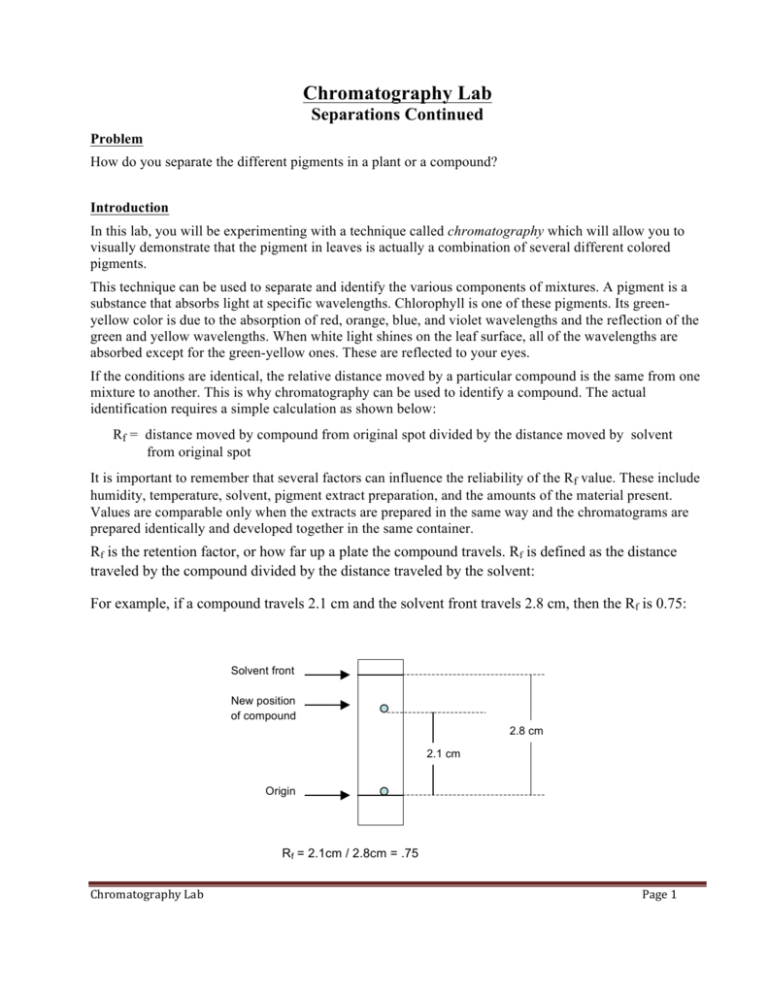
Chromatography Lab Separations Continued Problem How do you separate the different pigments in a plant or a compound? Introduction In this lab, you will be experimenting with a technique called chromatography which will allow you to visually demonstrate that the pigment in leaves is actually a combination of several different colored pigments. This technique can be used to separate and identify the various components of mixtures. A pigment is a substance that absorbs light at specific wavelengths. Chlorophyll is one of these pigments. Its greenyellow color is due to the absorption of red, orange, blue, and violet wavelengths and the reflection of the green and yellow wavelengths. When white light shines on the leaf surface, all of the wavelengths are absorbed except for the green-yellow ones. These are reflected to your eyes. If the conditions are identical, the relative distance moved by a particular compound is the same from one mixture to another. This is why chromatography can be used to identify a compound. The actual identification requires a simple calculation as shown below: Rf = distance moved by compound from original spot divided by the distance moved by solvent from original spot It is important to remember that several factors can influence the reliability of the Rf value. These include humidity, temperature, solvent, pigment extract preparation, and the amounts of the material present. Values are comparable only when the extracts are prepared in the same way and the chromatograms are prepared identically and developed together in the same container. Rf is the retention factor, or how far up a plate the compound travels. Rf is defined as the distance traveled by the compound divided by the distance traveled by the solvent: For example, if a compound travels 2.1 cm and the solvent front travels 2.8 cm, then the Rf is 0.75: Solvent front New position of compound 2.8 cm 2.1 cm Origin Rf = 2.1cm / 2.8cm = .75 Chromatography Lab Page 1 The Rf for a compound is constant from one experiment to the next if the chromatography conditions for solvent system, adsorbent, thickness of the adsorbent, amount of material spotted and temperature also remain constant. Thus, Rf = distance moved by compound from original spot divided by the distance moved by solvent from original spot. Again, it’s important to remember that several factors including humidity, temperature, solvent, pigment extract preparation, and the amounts of the material present can influence the reliability of Rf. These values are comparable only when extracts and the chromatograms are prepared identically and developed together in the same container. Materials • Cone-type (size 4) coffee filter paper (or Whatman #1 chromatography paper) • Beakers • Solvents: hexane and ethyl acetate • capillary tubes • fresh spinach • mortar and pestle • clean sand Safety • Keep hexane, ethyl acetate, and acetone away from sparks or open flames. They are extremely flammable. • Wear eye protection. • Ethyl acetate is a very effective solvent for nail polish and acrylic plastics. You may wish to wear gloves! • Left-over solvents must be poured into the waste beaker in the hood. Procedure 1. Each lab group will need: 3 strips of chromatography paper, approximately 15 cm x 3 cm wide; 2 400 ml beakers; 2 solvents, hexane and ethyl acetate. Use solvents sparingly! 2. There are several ways to prepare the spinach extract! Your instructor will tell you what method to use (or which method s/he has used to speed things along). a) Do the following with both fresh spinach leaves; tear leaf material and place in a glass container, cover with acetone (this should be done the day before the actual lab activity). b) An alternative pigment extraction technique is to use a mortar and pestle. Place plant material the vessel; add a little clean sand and some acetone; and then grind until a dark green liquid appears. Chromatography Lab Page 2 Both techniques yield very dark pigment solutions with which to work. 3. Set up your chromatography chamber. You should read the “How to Guide” which is on-line. We will use a larger chamber than is shown (a 400 mL beaker); you can figure out what changes to make. Make a solution of 10 - 20 % ethyl acetate in hexane (by volume). You will need enough to cover the bottom of your beaker to a depth of 5 - 10 mm. The beaker will need a filter paper wick to help saturate the beaker’s atmosphere with solvent vapor. Pour the solvent mixture down the side of the beaker, wetting the wick. Cover the beaker tightly with an aluminum foil lid. 4. Make a pencil mark on each of the chromatography strips about 2 cm from the end of the paper. Dip a capillary tube into the spinach extract. Streak the capillary along the line, leaving a 5 mm margin on both sides of the strip. Dry the paper by waving it gently, or holding it in a gentle stream of air. Once it has dried, repeat this process 2 – 4 times. (You will have to judge whether you have enough material on your strip.) Allow the strip to dry thoroughly before developing your chromatogram. 5. Suspend your strip in the developing chamber, so that the end of the chromatography paper just touches your solvent. You can fold over a portion of the end and it should hang in place. Your chromatogram should not contact the wick! As the chromatogram develops, you will be able to see whether you have not enough or too much pigment applied. If you want to see better results, prepare another paper strip, using more or less pigment, as seems best. 6. Wait 20 to 30 minutes for the chromatograms to develop. Remove the chromatograms. Mark with a pencil (NOT a pen) where the solvent stopped as it moved up the chromatogram; this is called the solvent front. Mark the spot where each pigment stopped moving up the chromatogram. Using the equation below, determine a reference number for each pigment on the chromatograms. Depending on which chromatogram you are viewing, you should see greens, yellow/yellow orange, and red. All measurements should be in mm. (Any material which did not move from the pencil line is insoluble.) As time allows, you can experiment with other solvent mixtures. A less polar solvent mixture will use less ethyl acetate; why would we make the mixture less polar? A completely different solvent mixture can be made with acetone and water (80%:20%). Do you expect this to be more or less polar than the hexane:ethyl acetate mixture? Why might we want to use this? Remember, Rf = distance moved by compound from original spot divided by the distance moved by solvent from original spot. Each pigment has a special name: • bright green or yellowish green = chlorophyll a • bluish green = chlorophyll b • yellow/yellow orange = carotene • red = anthocyanin • brown = xanthophyll Chromatography Lab Page 3 The reference numbers for the chlorophylls previously obtained in this activity are: 0.28 = chlorophyll a, 0.18 = chlorophyll b (spinach). You need these numbers so that you can determine one chlorophyll from the other. Calculate reference fronts for all of your pigments. See whether your calculations come close to those above for chlorophyll a and b. Even if the numbers are different, is the order you obtained the same (i.e. did chlorophyll a have a greater Rf than chlorophyll b)? Conclusion - Questions 1. What reference numbers (Rf) did you calculate for chlorophyll a and chlorophyll b? 2. Why do some pigments move farther up the chromatogram than others? 3. Regardless of the exact Rf you obtained, would you expect that the order of the pigments on the chromatogram would change? Why or why not? 4. With what you have discovered about pigments, what conclusions can you make regarding the changing color of leaves in autumn? 5. What adaptive purposes do different colored pigments serve for a plant? Chromatography Lab Page 4
